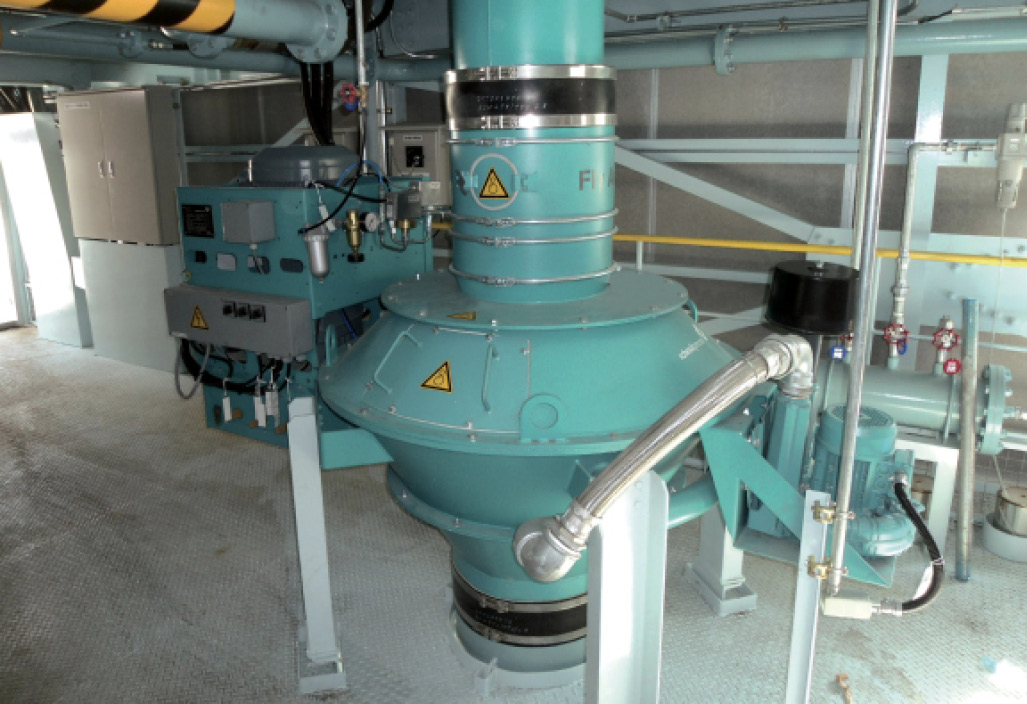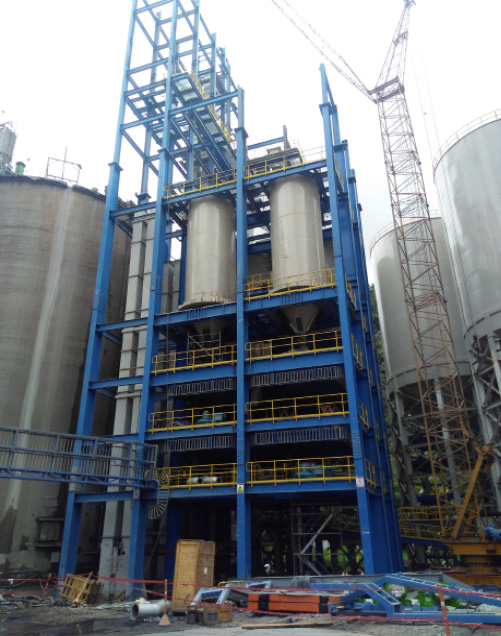World’s Largest Calcined Clay Kiln Requires Precise Metering And Blending.
By Ernesto Duran
Argos Rio Claro, Colombia, owned and operated by its parent company Cementos Argos, wanted to achieve a higher clinker substitution rate for its portland cement, by blending alternative cementitious materials. This substitution is helping to advance the company’s sustainability drive to achieve zero carbon emissions by 2050 or sooner. The resulting project involved construction of the world’s largest calcined clay kiln in operation to date, with a capacity of 1,500 tpd.
An operation of this type would normally require a complex system to manage, measure and mix materials with the level of accuracy required, yet Argos Rio Claro was able to manage its process updates with a compact system that simplified the process steps without sacrificing accuracy or efficiency.
The Challenges Posed by Calcined Clays
The company selected a natural pozzolanic ingredient for its formulation, calcined clay, and installed a production line with a capacity of up to 0.45 million metric tpy.
The final product, a pozzolanic cement (PPC), is gentler on the environment, cutting CO2 emissions by 38% compared to traditional cement processing, and utilizing 30% less energy than ordinary portland cement (OPC) production.
Mauricio Giraldo Orozco, director of combustible alternatives for Argos Rio Claro said that as a rule, the cement industry is “not keen on risk.” This new project, building such a large, calcined clay kiln, involved several unknowns.
Globally, many companies are working with calcined clays, said Giraldo. However, it presents a unique set of challenges, among them, the fact that the materials’ behavior is impossible to predict with 100% accuracy. There needs to be enough leeway to optimize the operation parameters – a difficult task considering the scale of the Rio Claro operation.
In addition, Argos required system flexibility to switch production according to market demand for various cement blends. The system needed to be able to adapt to production changes.
Argos needed an industry partner with the equipment and the experience crafting complete systems for this process, to help reduce the unknowns. It selected Schenck Process, a system provider with extensive experience providing technologies for alternative fuels and manufacturing methods for companies within the cement industry. Its technology could supply the precise measuring and blending the pozzolanic recipe requires, as well as system flexibility and sizing to handle required volume.
What is Pozzolan Cement?
The word “pozzolana” comes from an Italian reference to volcanic powder found near Vesuvius. A natural pozzolan would be any source material of volcanic origin or a sedimentary clay, while artificial pozzolans (also called semi cementitious materials, SCMs) stem from industrial wastes or processed materials, such as blast furnace slag, fly ash, or rice husk ash, for example. A material must have the ability to react with calcium hydroxide to qualify as a pozzolan and all are governed by ASTM International standards.
PPC is made by mixing 20% to 30% pozzolana or SCMs with OPC. When mixed with water or lime, pozzolanic materials undergo a reaction with calcium hydroxide that forms compounds with cement-like properties.
Ordinary portland cement (OPC) is the most common type used in the industry, a mixture of limestone, gypsum, and a calcareous material. OPC has great initial strength when mixed and requires less curing time than PPC.
During its lifetime, however, PPC has greater durability and workability, and it strengthens as it cures. In addition, PPC is more eco-friendly and, advantageous to the cement industry, has a lower cost of production than OPC because of its lower energy consumption.
The variety of materials in pozzolan dictates the necessity of careful metering and blending to achieve an end product with desired properties and behavior. Pozzolanic material reactivity is dependent on a variety of factors, such as individual particle size, material composition and temperature. Other considerations for a successful outcome include the composition of the parent material, constituent materials and curing times/procedures.
A pozzolan’s reaction time speeds up in proportion to higher temperatures or when used in conjunction with a high alkali portland cement. The material that the Argos plant intends to use, calcined clay, will increase workability. Other factors involved in reaction time include water requirements and recalibration of the chemical admixture.

Investment in Sustainable Business Practices
Cementos Argos invested $78 million to convert the production line for manufacturing and distribution of green cement.
The manufacture of pozzolan cement is more environmentally friendly in part since the incorporation of calcined clays reduces the use of the clinker. The pozzolana/clinker ratio is critically important to its functionality. This is what leads to reduced CO2 emissions and lower energy consumption.
According to a review in the journal Materials, “Alternative Clinker Technologies for Reducing Carbon Emissions in the Cement Industry,” “the two main CO2 contributors in [the cement] process are fossil fuel combustion to heat the rotary kiln and the chemical reaction associated with the calcination process, in the production of the clinker, the main component of OPC.” It further stated that “the production of one ton of clinker releases about 0.83 tons of CO2 and the production of one ton of OPC releases about 0.54 ton of CO2. The fossil fuel combustion to heat the cement kiln is responsible for 35% to 40% of the emissions.” There are numerous challenges facing any operation that switches from fossil fuels to a biomass energy source.
Pozzolanic materials in general, help create:
- Very fine Blaine size cement with low porosity to fill gaps between aggregates and reinforcement to reduce shrinkage or honeycomb formations, increasing the durability and strength of the end product.
- An eco-friendly manufacturing process that uses industrial byproducts that would otherwise be discarded as ingredients within the cement mixture.
- Material resistant to sulphate attacks, making it an excellent choice for hydraulic or marine structures, dam construction, etc.
- A reduction in carbon dioxide emissions compared to OPC.
The Importance of Accurate Measurements for Clinker Substitution
Clinker substitution requires very accurate measurements due to differing substitution rates depending on the grind of various supplementary materials. It also requires a thorough mixture of these ingredient blends to achieve a homogeneous result, one that has been correctly dosed. Said Giraldo, “Each and every cubic inch of the material in a bag of cement needs to be the same – well mixed – in order to supply a viable product to the end user when building something.”
According to Giraldo, this usually involves a complicated equipment system. One of the most practical solutions involved a compact arrangement utilizing two metering machines working in tandem. This allowed Cementos Argos to install the most cost effective, accurate and efficient solution for its processing.

The Schenck Process Complete Solution Specifics
Cementos Argos in 2019 launched a new type of pozzolanic cement called Cemento Verde.
It required a system that was easy to install, and that would minimize the plant footprint while supplying accurate metering – critical to creation of the new pozzolanic cement. Cementos Argos also preferred a complete solution from design and engineering through commissioning, as well as a supplier with service technicians local to Colombia.
The specific system parts Schenck Process supplied included a:
- MULTICOR Coriolis flow meter.
- Supervisory controls (DISOCONT TERSUS).
- Slide valves.
- Control valves.
- Air slides.
- Dust collectors.
- Blowers.
- Engineering drawings/designs.
Of particular value to Argos was the supplier’s technology for flow measurement and mixing, in its MULTICOR, a mass flowrate feeding/dosing metering device. This provides precise flow measurement according to the Coriolis principle. This is a unique measuring principle for bulk solids, independent of material property changes that can create errors in other measurement means.
The MULTICOR measures the material stream with an accuracy of ±0.5%. Mass flows are exactly measured and fed in conjunction with an adjustable pre-feeder. This precision offers the plant 1) cost savings by supplying exact throughput and 2) a high value final product.
From start to finish, the project took six months from design to installation. The system was installed and has been operational since the beginning of 2020.
Future Rollout of Argos Approach
According to Giraldo, “I want to see this type of system replicated because I believe it is going to be a game changer for the industry.”
He added, “Its overwhelming to go from a drawing to the site building and know that what you were planning to do actually worked. I was very proud to be involved with that team.”
Since installing the kiln in 2020, Schenck Process has supplied three more cement metering and blending lines in North America and is in the process of engineering several others.
According to Miguel R. Suarez N., vice president Regional Colombia for Cementos Argos, “The blending systems have shown very good behavior from a quality perspective due to the homogeneity we can achieve in the mixtures.”
Suarez listed some of the benefits from their chosen system:
1. Cost reductions traced to optimizing cement mill production.
2. Enhanced sustainability by reducing the cement’s carbon footprint by up to 38%.
3. Improved cement quality due to the mixing process supplying a higher degree of accuracy and tight standard deviations compared to previous practices.
4. Improved production flexibility. In line blending allows operators to rapidly change ratios and additives to meet market demand.
5. Streamlined facility capacity planning due to production improvements, which also optimized storage facilities due to the speed of dispatch of finished products and better use of storage silos.
Schenck Process is a supplier of bulk-handling industrial equipment, supporting a variety of sectors including steel and metals, aggregates, cement and gypsum processing, grain and agriculture, rail and electric utilities. Schenck Process provides new equipment as well as maintenance and material testing services, with equipment and systems for conveying, weighing, and metering, feeding, blending, injection, air filtration, as well as components and spare parts. Learn more at schenckprocess.com. Ernesto Duran can be reached at [email protected].



